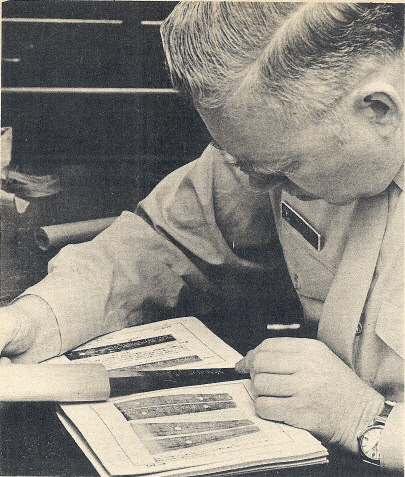 Colonel Dean Hartley Jr. examines the oldest sword in his collections, a blade made about 1065 A.D. On the scabbard, Japanese ideograms written by Dr. Junji Homma, a noted expert of Samurai swords, authenticate the sword's age and quality. |
The New Bedford Sunday Standard-Times, December 15, 1968
Photos and Text by PHC William M. Powers
 Colonel Dean Hartley Jr. examines the oldest sword in his collections, a blade made about 1065 A.D. On the scabbard, Japanese ideograms written by Dr. Junji Homma, a noted expert of Samurai swords, authenticate the sword's age and quality. |
|
Japanese Samurai swords are more than just a passing interest to Marine Colonel Dean S. Hartley Jr. Hartley, a member of the staff at the U.S. Naval War College in Newport, R.I., collects the swords and is considered to be an expert on them. He now has a collection of 65. He acquired his first swords in Guadalcanal Island during World War II and has gotten others in such diverse places as Japan and pawn shops in Washington, D.C. Samurai swords were originally carried by the soldier class of the lower nobility in feudal Japan. Many of the weapons are considered works of art. They are frequently embellished with engravings and inlaid gold filigree designs. This type of blade though, is considered more decorative than a practical weapon for combat. Of his collection, Hartley said he found 11 swords in pawn shops in Washington, D.C. A prominent authority on Samurai swords, Dr. Junji Homma, made a trip to Boston Museum a few years ago to examine their large collection of blades. As a special favor, he certified the authenticity of the oldest sword in Hartley's collection, a blade made about 1065 A.D. After World War II, the Japanese shunned war as a national policy. Since Samurai swords had been carried by the military and had a strong identification with aggressive war, they were not included as part of the uniform in the new Japanese Self Defense Forces. Most of the swords now made go to collectors or are made for ceremonial use. Sword making in Japan is a dying art. "There are perhaps 200 sword makers, including two Americans, of any quality," said Hartley. |
 Comparing the tang, or shank, of a sword against a photo in one of his reference books, Colonel Hartley catalogs it by checking the inscription. The maker and the province where the sword was made are [not] always inscribed. |
Website created by Dean S. Hartley III.